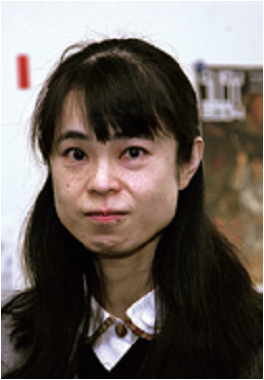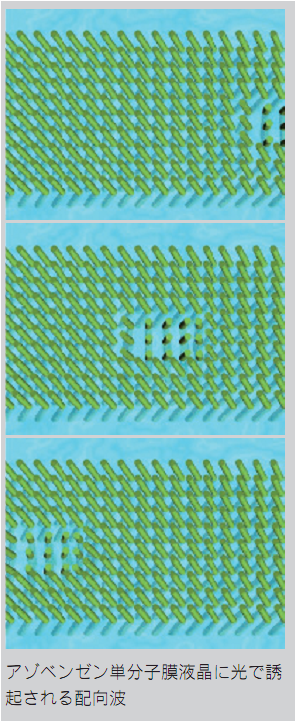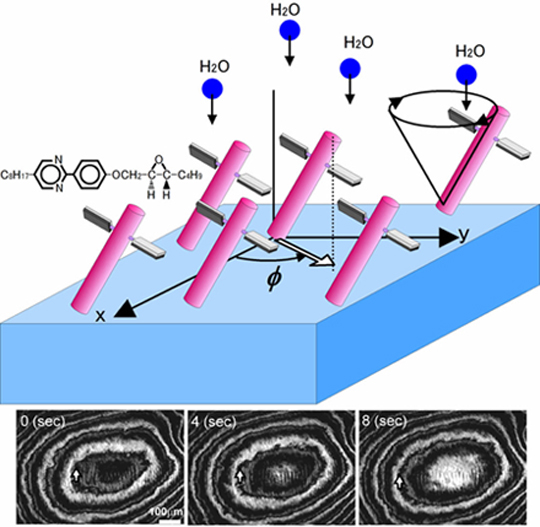
ページ読込中...

ページ読込中...

[English]
| 多辺 由佳 [教授] |  |
|
| homepage | https://tabe.w.waseda.jp/ | |
| 専門分野 | ソフトマター物理学研究 | |
| 研究テーマ・研究活動 | ||
| 1987 年 東京大学工学部物理工学科卒業 1989 年 工業技術院 電子技術総合研究所 超分子部 研究官 1996 年 博士( 工学) 東京大学 1996 年-1998 年 ハーバード大学物理学科 2005 年 早稲田大学理工学部・教授 |
||
液晶ときいて、皆さんは何を思い浮かべるでしょうか。携帯電話、パソコン、テレビなどの表示パネルを始め、薬品や化粧品などにも広く使われている他、私達の身体の中にある生体膜もまた液晶の1 種です。一般に液晶を構成する分子は棒のような形
をしていますが、このような棒状分子は液晶状態では、自由に動き回りながら常にその方向を互いにそろえようとします。この
柔らかくて強い異方的な分子間相互作用こそ液晶の特徴であり、表示パネルもこの性質を利用しているといえます。

液晶分子は、熱平衡構造で互いに向きをそろえるだけでなく、動く時も常に位相のそろった協調的な運動をしようとする性質
を持っています。私達は二次元の液晶を対象に、液晶分子の協調運動を研究してきました。厚さが数ナノメートル程度しかない
二次元液晶では、外場によってほんのわずか分子に引き起こされた変化が、三次元系と違って打ち消されることなく巨視的なダイナミクスへと発展しやすいからです。
これまで私達は、微弱な光で分子をわずかにつついた時に爆発的な分子の津波が発生したり、水を液晶膜に通過させた時に分子が集団で一斉に歳差運動をしたりするという、不思議な非平衡現象を見出してきました。柔らかく強い分子相関が主役となる非平衡ダイナミクスは、従来にない新しい液晶の可能性を与えるものであり、例えばこれを利用して、液晶ナノマシーンを実現することも夢ではないと考えています。
| Yuka Tabe [Professor] |  |
|
| homepage | https://tabe.w.waseda.jp/ | |
| research field | Non-equilibrium dynamics in 2D liquid crystals | |
| research keywords | ||
| Liquid crystals Non-equilibrium dynamics in softly condensed matter Cross-coupling of molecular motion and orientation |
||
| link | ||
| Research Profiles (at Faculty of Science and Engineering)Research Profiles (Elsevier SciVal Experts) | ||
Two-dimensional liquid crystals (LCs) exhibit unique structures that cannot be found in bulk LCs. LC films of several tens of nanometer in thickness are significantly influenced by the effects of surfaces and interfaces, which, coupled with large molecular fluctuations and fluidity (flexibility), give rise to various spontaneous patterns. Due to our interest in their dynamic properties, we have investigated spatio-temporal molecular movement in LC films induced by weak photo-excitation and transmembrane gas transfer. When an LC monolayer of azobenzene derivatives is formed on a water surface and illuminated by linearly polarized green light, molecular photo-isomerization on the order of a few percent develops into a collective pendulum motion involving the molecules, observed as macroscopic orientational waves. The direction of propagation and the speed of the waves can be determined by the polarization direction and the intensity of the excitation light, respectively. The phenomenon highlights the complex nature of liquid crystallinity. How the random molecular motions couple coherently, resulting in macroscopic wave generation and propagation, is currently being examined. Another unique trait observed in 2D LCs is collective molecular precession driven by transmembrane gas transfer. In chiral LC films, molecules may be regarded as having propellers made of chiral groups, enabling them to rotate in one direction under gas flow across the film like windmills or watermills. Liquid crystalline molecular interactions gradually synchronize the unidirectional but random rotations, resulting in the collective precession clearly visible under an optical microscope. It appears that soft and strong molecular orientational interactions play an essential role in both dynamic structures, but how this motion is transformed from the vastly differing scales ranging from nm to mm and from pico-seconds to micro-seconds is not yet understood. This multi-scale energy transformation is one of the unique properties of soft matter. In addition to inherent scientific interest, an understanding of the process of transformation in the mesoscopic region will help clarify life activities and help make possible soft nano-machines.

Collective precession of chiral molecules in an LC monolayer. The figure above is a schematic drawing of the system. The lower figure shows snapshots taken by a polarizing microscope. When the water vapor molecules permeate the LC monolayer, molecules with chiral propellers exhibit precession in a certain direction. The rate of precession varies linearly with differences in water vapor pressure. Inverting molecular chirality and flow direction will reverse its direction.